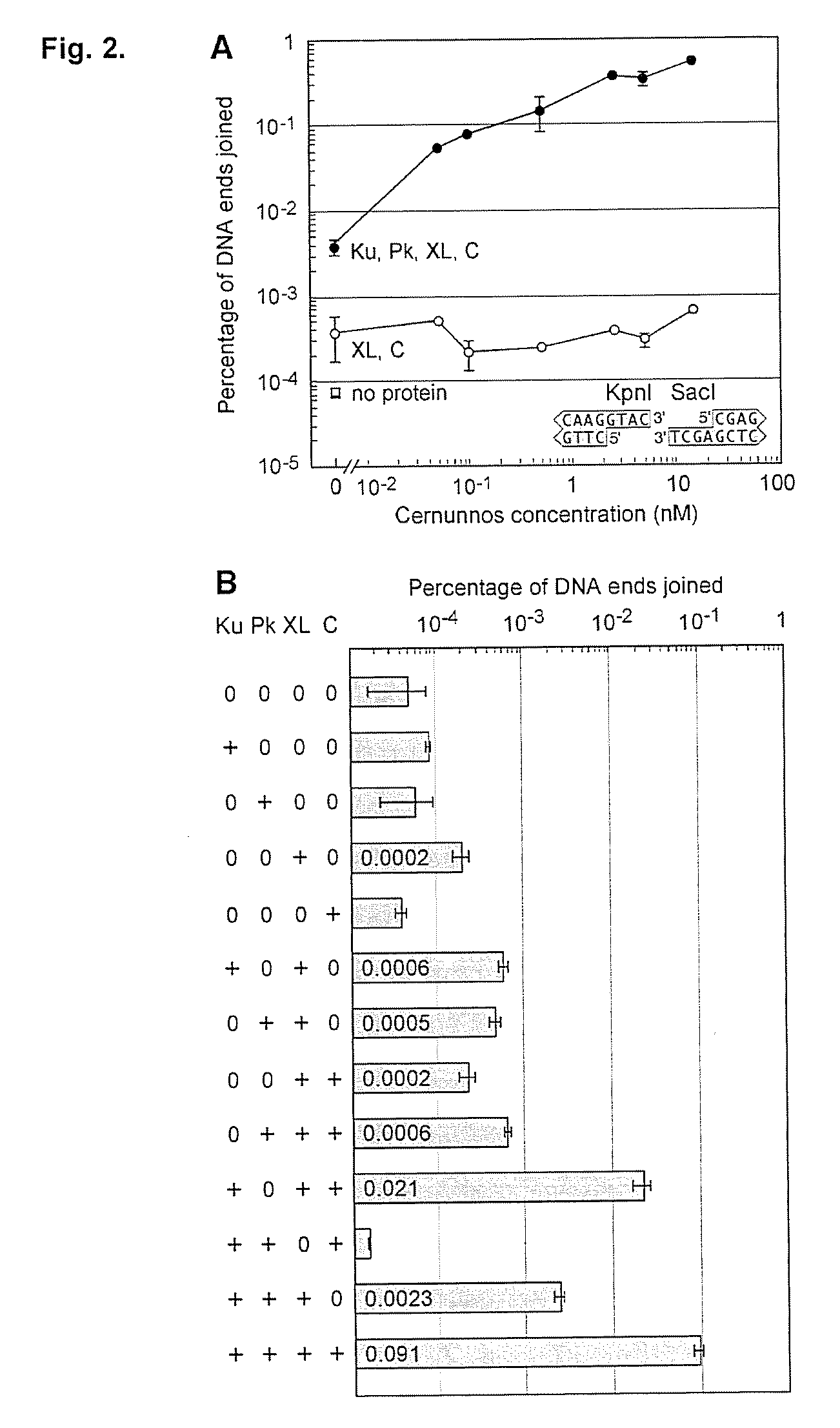Mismatched end DNA ligase
a ligase and end dna technology, applied in the field of mismatched end dna ligase, can solve the problems of low yield, various forms of immunodeficiency, genetic instability, etc., and achieve the effect of increasing retention and promoting retention of 5′ overhangs
- Summary
- Abstract
- Description
- Claims
- Application Information
AI Technical Summary
Benefits of technology
Problems solved by technology
Method used
Image
Examples
example 1
[0060]It was discovered that the proteins, Ku, Cernunnos, and XRCC4 / Ligase4 (XL) could ligate DNA ends with noncompatible 3′ overhangs. The DNA junctions always contained sequences in which one of the 3′ overhangs was preserved. Thus, the protein complex ligated a 3′ overhang to a recessed 5′ end, displaying a single-strand DNA ligase activity. Additional experiments demonstrated that the complex could ligate an end with a 3′ overhang to a blunt end or ligate two compatible ends. The ligation of noncompatible ends was 10% to 15% of that seen for compatible ends. DNA-PK boosts joining efficiency about 6-fold, but is not required. Upon addition of DNA-PK, ligation of noncompatible ends approached the efficiency seen for compatible ends.
example 2
Purification of Recombinant Ku70 / 86 Heterodimer
[0061]Purified recombinant Ku70 / 86 heterodimer was produced by co-infecting Sf9 insect cells with baculoviruses containing sequences encoding Ku70-His and Ku86. Infect with limiting amounts of Ku70 virus. Collect cells at about 48 hours post-infection and flash-freeze. Store at −80° C. For purification, lyse cells in lysis buffer of 50 mM Na.PO4 pH 8.0, 500 mM NaCl, 0.5% Igepal, 10% glycerol, 10 mM B-mercaptoethanol, 1 mM phenylmethanesulfonyl fluoride, 2.7 mM benzamidine, EDTA-free protease inhibitor cocktail tablet [Roche]). Sonicate cells. Clarify lysate with centrifugation in SS-34 rotor at 15,500 rpm for 30 minutes. Collect supernant. Incubate with Ni-NTA beads in 20 mM imidazole. Wash 3× with wash buffer: 50 mM Na.PO4 pH 7.4, 500 mM NaCl, 40 mM imidazoles, 0.5% Igepal, 10% glycerol, 10 mM B-ME). Elute with: 50 mM Na.PO4 pH 7.4, 500 mM NaCl, 300 mM imidaole, 10% glycerol, 10 mM B-mercaptoethanol. Purify over Superose-12 gel filtrat...
example 3
Purification of Endogenous DNA-PKcs from HeLa Cells
[0062]Endogenous DNA-PKcs was purified by coupling Ku80C-derived peptide (KGSGEEGGDVDDLLDMI) to 1-ml NHS-activated HiTrap column (GE Healthcare). Dissolve 20 mg of the peptide in 1 ml of coupling buffer. Wash 1 ml of NHS-activated HiTrap resin with coupling buffer. Pour into column and incubate with peptide overnight 4° C. Inject 6 ml of solution A. Inject 6 ml of solution B. Inject 6 ml of solution A. Leave the column overnight at +4° C. Inject 6 ml of solution B. Inject 6 ml of solution A. Inject 6 ml of solution B. Inject 2 ml of storage buffer. Coupling Buffer: 0.2 M NaHCO3 pH=8.3, 0.5 M NaCl; Solution A: 0.5 M 2-aminoethanol, 0.5 M NaCl, pH=8.3; Solution B: 0.5 M NaCl, pH=4; Storage Buffer: 0.05 M Na2HPO4, 0.1% NaN3, pH=7.
[0063]Prepare nuclear extracts from 10 L HeLa cells (ordered from National Cell Culture Center). Thaw cells. Resuspend in 4 packed cell volumes of hypotonic lysis buffer: 10 mM KCl, 10 mM Tris-HCl, pH 7.9, 1 m...
PUM
| Property | Measurement | Unit |
|---|---|---|
| total volume | aaaaa | aaaaa |
| pH | aaaaa | aaaaa |
| pH | aaaaa | aaaaa |
Abstract
Description
Claims
Application Information
 Login to View More
Login to View More - R&D
- Intellectual Property
- Life Sciences
- Materials
- Tech Scout
- Unparalleled Data Quality
- Higher Quality Content
- 60% Fewer Hallucinations
Browse by: Latest US Patents, China's latest patents, Technical Efficacy Thesaurus, Application Domain, Technology Topic, Popular Technical Reports.
© 2025 PatSnap. All rights reserved.Legal|Privacy policy|Modern Slavery Act Transparency Statement|Sitemap|About US| Contact US: help@patsnap.com



